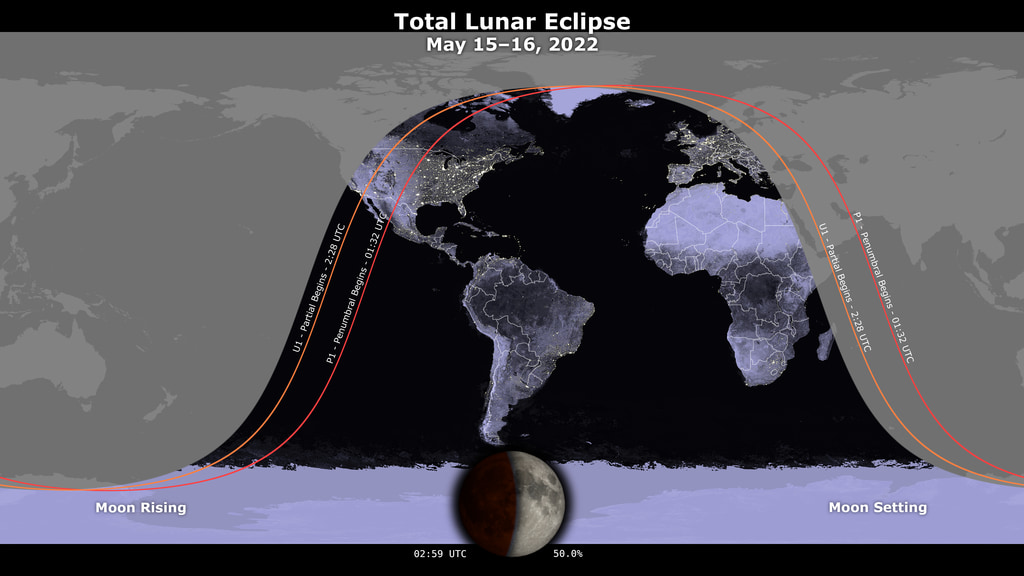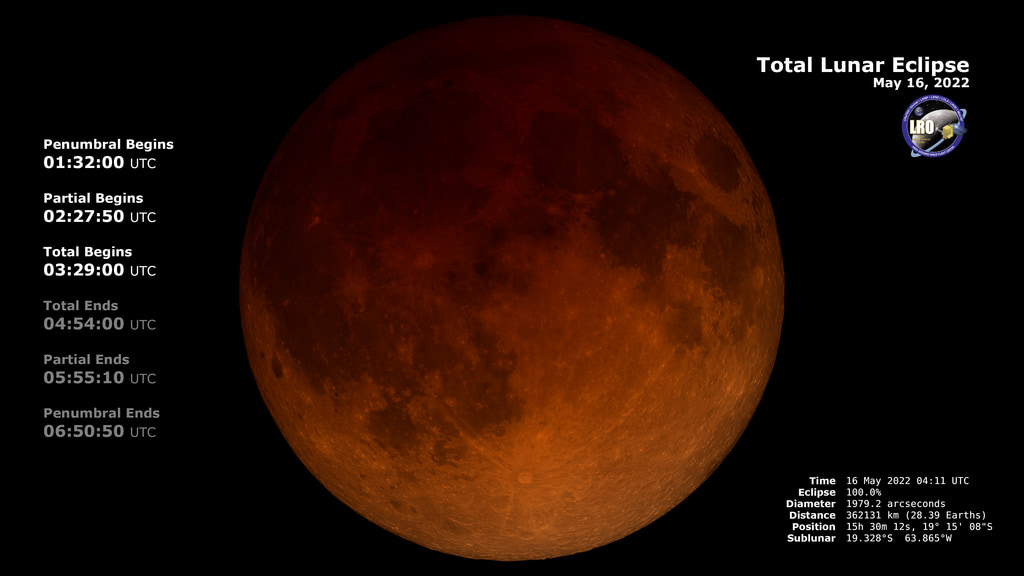May 15-16, 2022 Total Lunar Eclipse: Shadow View
Eastern Daylight Time (EDT). The Moon moves right to left, passing through the penumbra and umbra, leaving in its wake an eclipse diagram with the times at various stages of the eclipse.
Both movies and high-resolution still images are available for Eastern (above), Central, Mountain, and Pacific Daylight Time, as well as UTC. Also see the visibility map and Dial-a-Moon for this eclipse.
On May 16, 2022 (the night of May 15 in the Western Hemisphere), the Moon enters the Earth's shadow, creating a total lunar eclipse, the first since May of 2021. This animation shows the changing appearance of the Moon as it travels into and out of the Earth's shadow, along with times at various stages.
The penumbra is the part of the Earth’s shadow where the Sun is only partially covered by the Earth. The umbra is where the Sun is completely hidden. The Moon's appearance isn't affected much by the penumbra. The real action begins when the Moon starts to disappear as it enters the umbra at about 10:28 p.m. EDT on the 15th. An hour later, entirely within the umbra, the Moon is a ghostly copper color. Totality lasts for an hour and a half before the Moon begins to emerge from the central shadow. Throughout the eclipse, the Moon is moving throught the constellation Libra.
Universal Time (UTC). The Moon moves right to left, passing through the penumbra and umbra, leaving in its wake an eclipse diagram with the times at various stages of the eclipse.
During the eclipse, the Moon moves through the constellation Libra. The more prominent stars of neighboring Scorpius, in the lower left, include orange Antares (α Sco, on the bottom edge of the frame).
Central Daylight Time (CDT). The Moon moves right to left, passing through the penumbra and umbra, leaving in its wake an eclipse diagram with the times at various stages of the eclipse.
Mountain Daylight Time (MDT). The Moon moves right to left, passing through the penumbra and umbra, leaving in its wake an eclipse diagram with the times at various stages of the eclipse.
Pacific Daylight Time (PDT). The Moon moves right to left, passing through the penumbra and umbra, leaving in its wake an eclipse diagram with the times at various stages of the eclipse.
General. The Moon moves right to left, passing through the penumbra and umbra, leaving in its wake an eclipse diagram. This version omits the title and times.
Just the Moon.
Credits
Please give credit for this item to:
NASA's Scientific Visualization Studio
-
Visualizer
- Ernie Wright (USRA)
-
Technical support
- Laurence Schuler (ADNET Systems, Inc.)
- Ian Jones (ADNET Systems, Inc.)
Release date
This page was originally published on Thursday, March 24, 2022.
This page was last updated on Thursday, January 30, 2025 at 12:11 AM EST.
Missions
This page is related to the following missions:Series
This page can be found in the following series:Datasets used
-
DEM (Digital Elevation Map) [LRO: LOLA]
ID: 653 -
DE421 (JPL DE421)
ID: 752Planetary ephemerides
This dataset can be found at: http://ssd.jpl.nasa.gov/?ephemerides#planets
See all pages that use this dataset -
LROC WAC Color Mosaic (Natural Color Hapke Normalized WAC Mosaic) [Lunar Reconnaissance Orbiter: LRO Camera]
ID: 1015This natural-color global mosaic is based on the 'Hapke normalized' mosaic from LRO's wide-angle camera. The data has been gamma corrected, white balanced, and range adjusted to more closely match human vision.
See all pages that use this dataset
Note: While we identify the data sets used on this page, we do not store any further details, nor the data sets themselves on our site.


